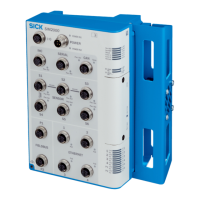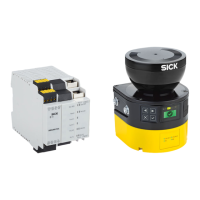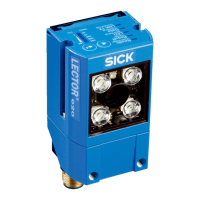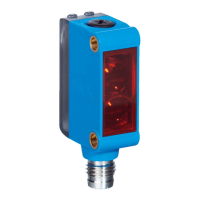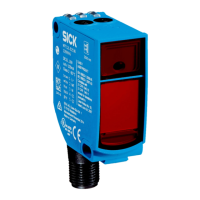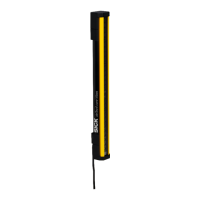b
T
est the function of the protective device. To do this, trigger the protective function
once and observe the response of the safety outputs, for example based on the
response of the machine.
°
Any application: During the test, observe whether the device indicates the
detection within the protective field using the LEDs.
°
Stationary application (hazardous area protection, access protection, hazard‐
ous point protection):
•
Position the test object within the protective field and check whether the
machine stops.
°
Mobile application (mobile hazardous area protection):
•
Place the supplied test object in the path of the vehicle and observe
whether the vehicle stops.
OR
•
A
ctivate a protective field in which at least one test object is located and
check that the response is as expected (for example using an automatic
test in the safety controller).
If the thorough check reveals a fault, the machine should be shut down immediately.
In this case, the mounting and electrical installation of the device must be checked by
appropriately qualified safety personnel.
Thorough check of the area to be protected
T
he area to be protected and the detection capability are examined during this thor‐
ough check.
The thorough check covers the following points:
•
Changes in the detection capability (thorough check of all configured fields)
•
Modifications, tampering and damage to the protective device or the machine,
which lead to changes in the area to be protected or the position of the protective
field
Recommended approach for hazardous area protection:
b
Position the supplied test object at a number of points at the edges of the area to
be protected. The safety camera sensor must detect the test object at each posi‐
tion and indicate the detection. How it is indicated depends on the configuration.
The number and position of sites where the thorough check is carried out must be
chosen so that undetected access to the hazardous area is impossible.
b
If a number of protective fields are used (in different monitoring cases for exam‐
ple), check the edges of all protective fields.
b
Using the intended test object, check whether the distance of the protective
field to the floor is within the required range. Perform this test along all lateral
boundaries of the protective field.
b
If a protective field extends to a wall or other mechanical barrier, use the intended
test object to check whether the area between the protective field and the wall is
of the required size and that it is not possible to step behind or reach behind at
these points.
Recommended approach for access protection and hazardous point protection:
b
Move the supplied test object along the edges of the area to be protected. The
safety camera sensor must detect the test object at each position and indicate the
detection. How it is indicated depends on the configuration. The protective field
must be dimensioned such that reaching around or going around it is impossible.
b
If a number of protective fields are used (in different monitoring cases for exam‐
ple), check the edges of all protective fields.
Recommended approach for mobile hazardous area protection:
b
Place the supplied test object in the path of the vehicle and check whether the
vehicle comes to a stop in time.
4 P
ROJECT PLANNING
48
O P E R A T I N G I N S T R U C T I O N S | safeVisionary2 8025919/1I9E/2023-01-09 | SICK
Subject to change without notice
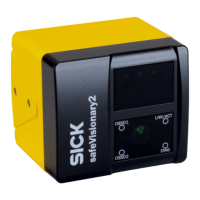
